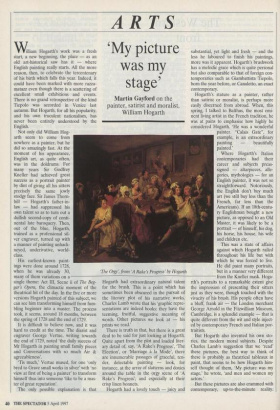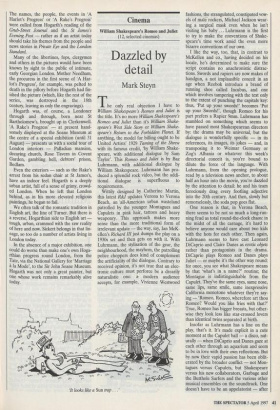ARTS
`My picture was my stage'
Martin Gayford on the painter, satirist and moralist, William Hogarth William Hogarth's work was a fresh start, a new beginning, the place — as an old art-historical saw has it — where English painting really starts. All the more reason, then, to celebrate the tercentenary of his birth which falls this year. Indeed, it could have been marked with more razza- matazz even though there is a scattering of excellent small exhibitions and events. There is no grand retrospective of the kind Tiepolo was accorded in Venice last autumn. But Hogarth, for all his popularity, and his own truculent nationalism, has never been entirely understood by the English.
Not only did William Hog- arth seem to come from nowhere as a painter, but he did so amazingly fast. At the moment of his appearance, English art, as quite often, was in the doldrums. For many years Sir Godfrey Kneller had achieved great success as a portrait painter by dint of giving all his sitters precisely the same jowly stodgy face. Sir James Thorn- hill — Hogarth's father-in- law — had suppressed his own talent so as to turn out a dullish second-copy of conti- nental late baroquery. Then, out of the blue, Hogarth, trained as a professional sil- ver engraver, turned up with a manner of painting unhack- neyed, underivative, world- class.
His earliest-known paint- ings were done around 1728, when he was already 30, many of them variations on a single theme: Act III, Scene ii of The Beg- gar's Opera, the climactic moment of the theatrical hit of the day. In the five or more versions Hogarth painted of this subject, we can see him transforming himself from fum- bling beginner into a master. The process took, it seems, around 18 months, between the spring of 1728 and the end of 1729.
It is difficult to believe now, and it was hard to credit at the time. The diarist and engraver George Vertue, writing towards the end of 1729, noted 'the daily success of Mr Hogarth in painting small family pieces and Conversations with so much Air & agreeableness'.
`Tis much,' Vertue mused, for one 'only bred to Grave small works in silver' with 'no view at first of being a painter' to transform himself thus into someone 'like to be a mas- ter of great reputation'.
The only possible explanation is that `The Orgy, from 'A Rake's Progress' by Hogarth Hogarth had extraordinary natural talent for the brush. This is a point which has sometimes been obscured in the pursuit of the literary plot of his narrative works. Charles Lamb wrote that his 'graphic repre- sentations are indeed books: they have the teeming, fruitful, suggestive meaning of words. Other pictures we look at — his prints we read.'
There is truth in that, but there is a great deal to be said for just looking at Hogarth. Quite apart from the plot and loaded liter- ary detail of, say, 'A Rake's Progress', 'The Election', or 'Marriage a la Mode', there are innumerable passages of graceful, ten- der, delectable painting — look, for instance, at the array of slatterns and doxies around the table in the orgy scene of 'A Rake's Progress', and especially at their crisp linen bonnets.
Hogarth had a lovely touch — juicy and substantial, yet light and fresh — and the less he laboured to finish his paintings, more was it apparent. Hogarth's brushwork has a melodic grace which is quite personal but also comparable to that of foreign con- temporaries such as Giambattista Tiepolo, born the year before, or Canaletto, an exact contemporary.
Hogarth's stature as a painter, rather than satirist or moralist, is perhaps more easily discerned from abroad. When, this spring, I talked to Balthus, the most emi- nent living artist in the French tradition, he was at pains to emphasise how highly he considered Hogarth. 'He was a wonderful painter. "Calais Gate", for example, is an extraordinary painting — beautifully painted.'
Where Hogarth's Italian contemporaries had their career and subjects preas- signed — altarpieces, alle- gories, mythologies — for an English painter, it was not so straightforward. Notoriously, the English don't buy much art (we still buy less than the French, far less than the Americans). If an 18th-centu- ry Englishman bought a new picture, as opposed to an Old Master, it was likely to be a portrait — of himself, his dog, his horse, his house, his wife and children etc.
This was a state of affairs against which Hogarth railed throughout his life but with which he was forced to live. He did paint many portraits, but in a manner very different from the Kneller mask. Hoga- rth's portraits to a remarkable extent give the impression of presenting their sitters just as they were, though touched with the vivacity of his brush. His people often have a bluff, frank air — the London merchant George Arnold in the Fitzwilliam Museum, Cambridge, is a splendid example — that is quite different from the wit and style inject- ed by contemporary French and Italian por- traitists.
But Hogarth also invented his own sto- ries, the modern moral subjects. Despite Charles Lamb's suggestion that we 'read' these pictures, the best way to think of these is probably as theatrical tableaux in paint, that seems to be how Hogarth him- self thought of them, 'My picture was my stage,' he wrote, 'and men and women my actors.'
But these pictures are also crammed with contemporary, up-to-the-minute reality. The names, the people, the events in 'A Harlot's Progress' or 'A Rake's Progress' were culled from Hogarth's reading of the Grub-Street Journal and the St James's Evening Post — rather as if an artist today should take his themes from the people and news stories in Private Eye and the London Standard.
Many of the libertines, fops, clergymen and others in the pictures would have been known by sight to the public of intimate, early Georgian London. Mother Needham, the procuress in the first scene of 'A Har- lot's Progress', for example, was pelted to death in the pillory before Hogarth had fin- ished the picture (which, like the rest of the series, was destroyed in the 18th century, leaving us only the engravings).
Hogarth was, of course, a Londoner through and through, born near St Bartholomew's, brought up in Clerkenwell. `A Rake's Progress' — at present hand- somely displayed at the Soane Museum at the centre of a special exhibition (until 31 August) — presents us with a social tour of London interiors — Palladian mansion, decaying church, Rose Tavern in Covent Garden, gambling hell, debtors' prison, Bedlam.
Even the exteriors — such as the Rake's arrest from his sedan chair at St James's, have an indoor feel. Hogarth is a deeply urban artist, full of a sense of grimy, crowd- ed London. When he left that London behind, as in his more elevated religious paintings, he began to fail.
We often talk of the romantic tradition in English art, the line of Turner. But there is a reverse, Hogarthian side to English art tough, urban, crammed with the raw reality of here and now. Sickert belongs in that lin- eage, so too do a number of artists living in London today.
In the absence of a major exhibition, one Could do worse than make one's own Hoga- rthian progress round London, from the Tate, via the National Gallery for 'Marriage a la Mode', to the Sir John Soane Museum. Hogarth was not only a great painter, but one whose work remains remarkably alive today.



























































 Previous page
Previous page